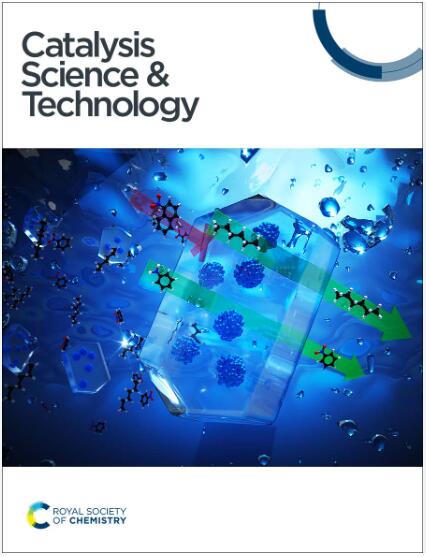用H2O2†对甲烷进行水相部分氧化,使微孔FeS-1催化剂上甲醇选择性最大化
IF 4.4
3区 化学
Q2 CHEMISTRY, PHYSICAL
引用次数: 0
摘要
由于甲醇选择性较低,甲烷转化为甲醇在液相系统中面临挑战,通常会导致较高的甲酸产量。先前的研究表明,铁交换的MFI沸石,即Fe-ZSM-5,由于氧化剂的不加区分的分解,更倾向于甲酸而不是甲醇。为了解决这个问题,我们的研究旨在确定导致这种过度氧化的活性位点,并开发抑制这些位点的方法,从而提高甲醇的选择性。因此,我们利用水热合成的具有MFI结构的微孔硅酸铁-1 (FeS-1),并与分别含有框架铁位点和框架外铁位点的FeZSM-5和Fe-ZSM-5进行了系统的催化性能比较。这一比较突出了活性位点分布与甲醇选择性之间的关系。此外,利用DRUV-VIS和EPR光谱技术分析表明,新鲜FeS-1分子筛基质中框架和框架外位置的铁含量分别与甲醇和甲酸的产率单调变化。因此,选择性去除框架外铁和/或部分溶解mfi基催化剂中的框架铁会显著降低甲酸收率,而对甲醇收率影响很小。有趣的是,与Fe-ZSM-5相比,FeZSM-5和FeS-1在框架位点上都保持了大量的框架铁,这导致甲醇选择性显著提高(65%)。对FeS-1、FeZSM-5和Fe-ZSM-5的进一步研究强调了框架Si-O-Fe键在提高甲醇选择性方面的重要性。本文章由计算机程序翻译,如有差异,请以英文原文为准。
Maximizing methanol selectivity over the microporous FeS-1 catalyst via aqueous-phase partial oxidation of methane with H2O2†
The conversion of methane to methanol faces challenges in liquid-phase systems due to lower methanol selectivity, often resulting in higher formic acid production. Previous studies have shown that iron-exchanged MFI zeolites, i.e., Fe–ZSM-5, tend to favor formic acid over methanol due to the indiscriminate decomposition of the oxidant. To address this, our study aims to identify the active sites responsible for such over-oxidation and develop methods to suppress these sites, thereby enhancing methanol selectivity. Hence, we have utilized hydrothermally synthesized microporous iron silicalite-1 (FeS-1) with an MFI structure and conducted a systematic comparison of its catalytic performance with FeZSM-5 and Fe–ZSM-5, which contain framework and extra-framework iron sites, respectively. This comparison highlights the relationship between active site distribution and methanol selectivity. Additionally, the analysis using DRUV-VIS and EPR spectroscopic techniques suggests that the yield of methanol and formic acid is found to vary monotonically with the amount of iron in framework and extra-framework sites, respectively, in the zeolitic matrix of fresh FeS-1. Therefore, selectively removing extra-framework iron and/or partially dissolving framework iron in MFI-based catalysts results in a significant reduction in formic acid yield, with only a small effect on methanol yield. Interestingly, in contrast to Fe–ZSM-5, both FeZSM-5 and FeS-1 maintain a significant amount of framework iron in the framework sites which results in a prominent enhancement in methanol selectivity (65%). Further investigation into FeS-1, FeZSM-5, and Fe–ZSM-5 underscored the importance of framework Si–O–Fe linkages in enhancing methanol selectivity.
求助全文
通过发布文献求助,成功后即可免费获取论文全文。
去求助
来源期刊

Catalysis Science & Technology
CHEMISTRY, PHYSICAL-
CiteScore
8.70
自引率
6.00%
发文量
587
审稿时长
1.5 months
期刊介绍:
A multidisciplinary journal focusing on cutting edge research across all fundamental science and technological aspects of catalysis.
Editor-in-chief: Bert Weckhuysen
Impact factor: 5.0
Time to first decision (peer reviewed only): 31 days
 求助内容:
求助内容: 应助结果提醒方式:
应助结果提醒方式:


